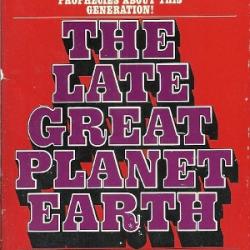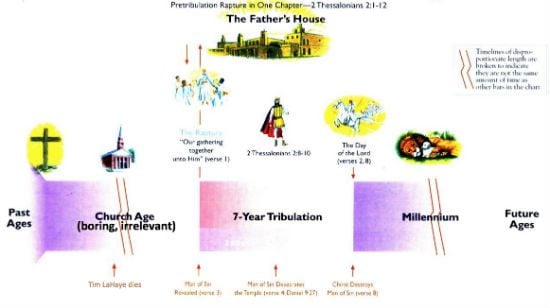Shortly after starting to work our way through the first book in the Left Behind series, we noted that Tim LaHaye and Jerry B. Jenkins seemed to be "Recycling Sydney Watson."
Watson was an early 20th-century novelist who produced a trilogy of End Times books — Scarlet and Purple, The Mark of the Beast and In the Twinkling of an Eye — from 1913 to 1916.
Writing in Books & Culture, Crawford Gribben noted L&J's many instances of flagrant borrowing from Watson's story, concluding that: "At best the novels are deeply intertextual; at worst, it might even be claimed, elements of their fictions are explicitly derivative." (I think "deeply intertextual" would be a wonderful phrase to hide behind for any college student caught plagiarizing.)
What I want to highlight here are the dates of publication of Watson's trilogy. These apocalyptic works were produced before the American involvement in World War I,* before the fundamentalist/modernist chasm erupted in the 1920s, and before Einstein and Heisenberg and the rest pulled the rug out from under modernity.
Watson was thus ahead of his time. The gloomy, fatalistic pessimism of Darby's premillennial dispensationalism was still more of a fringe phenomenon, the province of Seventh Day Adventists, but not yet of most American evangelicals. Cyrus Scofield had completed the first version of his PMD Reference Bible, but the influential final version wouldn't appear until after Watson's trilogy, in 1917.
When Sydney Watson was publishing his fictional prophecies of doom and gloom, the prevailing spirit in American Christianity — including among evangelicals — was an optimistic faith in inevitable progress. Glory, glory, hallelujah, God's truth is marching on. The outlook was millennial.** Society was improving, and the idea was that it would continue to improve to a state of perfection. Slavery had been abolished and soon other social ills — the drinking of alcohol, for example — would be abolished too. Whether or not we succeeded in electing William Jennings Bryan, we were destined, manifestly, to continue the process that Baptist theologian Walter Rauschenbusch in his 1912 book called Christianizing the Social Order. Rauschenbusch today might be thought of as more of a "mainline Protestant" than an "evangelical," but those dividing lines had not yet been drawn when he and Watson were writing. His theology drew upon the utopian outlook described in Charles Sheldon's runaway best-seller In His Steps — the book that gave us the question, "What Would Jesus Do?"
Sheldon was unquestionably evangelical, but he was also, at the very least, sympathetic to the idea of what was then called "Christian socialism," which tells you all you really need to know about the zeitgeist of American evangelicalism at the dawn of the 20th century. In His Steps was a juggernaut of a best-seller for years following its publication in 1896 (in part due to the failure of Sheldon's original publisher to secure the copyright). It was a publishing phenomenon along the lines of Harry Potter or the Da Vinci Code or, yes, the Left Behind series. Watson's trilogy, on the other hand, proved to be influential — creating the template copied by scores of later writers — but was nowhere near as widely read as Sheldon's book.
I have not read Sydney Watson's books, but I'm going to go out on a limb and guess that they were at least as well-written and engaging as L&J's later, derivative series (ahem). So why, then, are L&J gazillionaires at the helm of a publishing empire while Watson's books are obscure and out of print?
Two reasons, I think. Timing and marketing.
Watson was not just ahead of his time, but against it. He was peddling pessimism before it was all the rage. And he had the misfortune of publishing his series before the success of Scofield's 1917 Reference Bible prepared the soil.
A similar misfortune befell the publication of Olive Ruth Brown Pattison's apocalyptic thriller published by Fleming H. Revell/Spire Books. The paperback edition, as you've already seen from the picture above, was called Left Behind. (The hardcover edition was originally published, a few months earlier, as The Undelivered.)
Yep, same title. Same premise. Very similar End Times check list. But this book barely registered when it was published in 1969. Apart from the echo of its title in the current blockbuster series, O.R.B. Pattison's book left little trace on the evangelical subculture. I'd never even heard of this book's existence until Atrios sent me a copy (thank you again, kind sir) and I spent a chunk of my childhood helping my mother create card catalogs for the libraries of both a PMD church and private school.
I can't really say that Pattison's Left Behind is a good book, but it is far more engaging and better written than the World's Worst Books are. (That sets the bar very low, but it clears it.) Here, for example, is how Pattison's story begins:
Beyond the jockeying congestion of Constitution Avenue, the traffic inched across Arlington bridge, accelerating slightly as it swept into the low rolling hills of Virginia. Heat mirages shimmered from the sun-baked paving.
Evans scrubbed his handkerchief over his forehead and blond brush-cut hair, irritably. Only Wednesday, he thought. Wednesday: two more days to go before the weekend. …
Ken Evans is already far more appealing than either Rayford Steele or Buck Williams ever manages to be. And unlike L&J — who have Manhattan stretching into central Connecticut while cruise ships sail in the Jordan River — she presents a recognizable geography of Washington and its suburbs. Pattison's hints of sci-fi detail for her not-so-distant-future setting all seem, like that Electro Town Car, a bit quaintly dated, but not too bad for 1969.
So Pattison's lack of success relative to L&J thus can't be attributed to her book's relative lack of appeal. Her problem was that she was writing in 1969 while their series began publication in 1995. The world of difference there is that L&J were writing post-Hal Lindsey while O.R.B.P. was writing pre-Hal Lindsey.****
Lindsey, you may recall, was the author of runaway best-sellers in the 1970s including The Late Great Planet Earth, There's a New World Coming and Satan Is Alive and Well on Planet Earth. Like Scofield in 1917, Lindsey benefitted from impeccable timing, popularizing a brand of apocalyptic pessimism just as the broader culture began to adopt a similarly pessimistic outlook. Lindsey caught the wave of the zeitgeist that Pattison just missed and he rode it for a decade, making a fortune while indoctrinating a whole generation of evangelicals. He blazed the trail that L&J would follow.
Spire Books tried to follow that trail, reissuing Pattison's novel along with its own mass market editions of other apocalyptic PMD books throughout the 1970s, including Lindsey's The Terminal Generation and titles like Frank Allnut's The Antichrist After The Omen ("Learn the truth about the Satanic mission of the Antichrist, and how you can prepare for his coming"). But they never really had the marketing muscle that Tyndale was able to put behind L&Js later novels.
In retrospect, Pattison should have agreed to be a "co-author" of the book she wrote, the way that Jerry B. Jenkins is listed (second) as the co-author of the books he wrote. Left Behind by Jerry B. Jenkins likely would have enjoyed the same lackluster marketing and sales that Left Behind by O.R.B. Pattison did. But Left Behind by Tim LaHaye and Jerry B. Jenkins had a Big Name on the cover, and that Big Name meant Big Marketing and Big Sales.
Unlike Jenkins, however, Pattison wasn't a hired gun. LaHaye thought a book would sell so he slapped some notes on a napkin and hired Jerry Jenkins to write the thing. Jenkins didn't have the pride of ownership that Pattison earned from choosing, on her own, to sit down and write a novel. Too bad for her. A 1980 re-release of her Left Behind repackaged as &
quot;by Hal Lindsay with O.R.B.
Pattison," or "by John Walvoord and O.R.B. Pattison," might have made her a very wealthy woman.*****
After all this talk of zeitgeist it's tempting to interpret (or impose) some kind of grand pattern, both within the evangelical subculture and the larger culture that hosts it, of an oscillation between millennialist optimism and fatalism, whether premillennial or otherwise. And it would be even more tempting, then, to use such a pattern as an argument for my own position of a Niebuhrian, chastened hopefulness as a kind of Golden Mean. But to be honest, I'm not really confident in my ability to interpret such things.
During the 1990s, as I was working for the group that launched what would eventually become the Evangelical Environmental Network, I used to riff about how I thought this effort would become easier at the beginning of the 21st century, after the fin de siecle alarmism of the late 20th century had worked itself out and been proven false. By then, I figured, two thousand zero zero would have come and gone and people would realize that it didn't mean party's over whoops out of time.
But while EEN's message of "creation care" is proving to be more influential than I'd ever hoped it might be, apocalyptic alarmism is as perniciously popular among American evangelicals in 2009 as it was in 1999. So what do I know?
In any case, LaHaye and Jenkins are just the latest in a long line of salesmen pushing this nonsense and there will be others. But while I expect to see plenty more of their kind — more Watsons, Scofields, Lindseys, Pattisons and LaHayes — that's not what I'm hoping for. I don't want to see anyone else offering a "deeply intertextual" variation on Sydney Watson's template. I want to see them start ripping off Charles Sheldon instead.
– – – – – – – – – – – –
* It may seem a bit overly tidy, but WWI really does serve as a watershed event for the death of millennial optimism. Or, to mix the metaphor, as the high-water mark of that millennial optimism — you can't get much more millennial than the idea of a "war to end all wars." This is why I don't really understand the saying, "There are no atheists in foxholes." The reality, as seen from the enduring cultural and theological repercussions of World War I, is rather that very few theists emerge from the trenches.
I actually somewhat agree with those post-theological theologians who say that God died in the trenches of World War I. "Inasmuch as ye have mustard gassed the least of these, my brethren, ye have done it unto me," God says. It wasn't the first time we'd killed him and it sure as Hell wouldn't be the last. But that's never the end of the story.
** The pre in premillennial comes from the idea that the world must end before Jesus returns to establish his millennial reign of perfect justice. Millennial here refers to the thousand-year reign of Christ mentioned in the Bible. This is, for most Christians, understood broadly as a statement of eschatological hope — in the end, there will be peace and justice, milk and honey, lions and lambs, etc. PMDs, as is their wont, interpret this in the style they call "literal," as a period of not less than and not to exceed 365,242 days*** during which Jesus Christ will literally reign as a literal king on a literal throne with a literal crown on his literal head. PMDs long for this literal reign of Christ just as other Christians long for the messianic reign of perfect justice. But while those other Christians believe that the reign of God is both now and not yet, and thus believe that we can and ought to work toward a more perfect justice here on earth, PMDs are relieved of this responsibility and, in fact, view such efforts as not merely futile, but perverse. The millennial reign, they believe, will not come until after the end of the world, until after the widening gyre spirals down to its nadir of suffering, sin and injustice. This is why PMDs so often sound like the villains on Buffy the Vampire Slayer, awaiting the day that the Hellmouth is opened and the longed-for apocalypse at last arrives.
*** Every fourth year, of course, being a leap year, except for century years not divisible by 400. John of Patmos, PMDs believe, was writing for Christians of our dispensation of time (and only for Christians of our time) and thus must have been divinely informed of the particular quirks of our Gregorian calendar.
**** Also pre-Frank Peretti. Before the runaway success of his spiritual warfare as Mortal Kombat! horror novels, the evangelical Christian book market viewed fiction as a distracting sideshow, a way of padding out the shelf next to the Narnia books and the Grace Livingston Hill.
***** She did go on to publish 10 more novels under the name Ruth Abbey. I'm tempted to call her Ruth "Northanger" Abbey, due to the titles of some of those novels: Prisoner of the Manor, Evil at Nunnery Manor, Bridge of Tears, House by the Tarn, Dream of Terror, etc.












